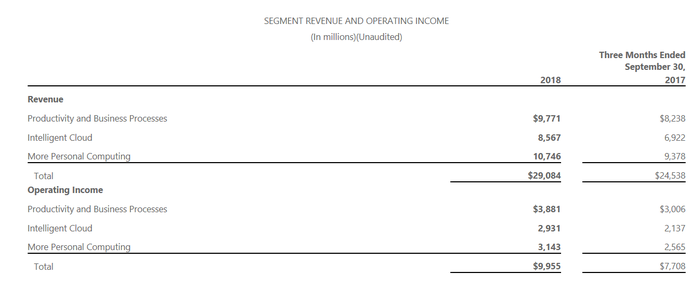Microsoft’s resurgence continues, driven by strength in cloud and gaming
Microsoft’s results demonstrated a continued upward trajectory, with the cloud and gaming units standing out with particularly strong performances.
October 25, 2018

Microsoft’s results demonstrated a continued upward trajectory, with the cloud and gaming units standing out with particularly strong performances.
Since wrapping up the last financial year by breaking the $100 billion annual revenue mark three months ago, Microsoft should not have been immune to the recent financial market gloom hanging over the technology sector. But the Q1 results of its financial year 2019 published on Wednesday are telling a different story.
On corporate level, the total revenue was $29.1 billion, up by 19% over the same period last year, and net income reached $8.8 billion, up by 34%, indicating an excellent management of both the top line and bottom line.
“We are off to a great start in fiscal 2019, a result of our innovation and the trust customers are placing in us to power their digital transformation,” said CEO Satya Nadella. “We’re excited to help our customers build the digital capability they need to thrive and grow, with a business model that is fundamentally aligned to their success.”
All the business units have registered growth, but the most impressive part is how balanced the company has become.

More Personal Computing continued to be the largest revenue contributor with $10.7 billion, an increase of 15%; this is a story of two extremes. Standing out in this group is the gaming division, which reported a revenue growth of 44%, with Xbox software and services revenue up by 36%, indicating its strategy to tie exclusive titles from gaming companies is reaping rewards. At the other end of the spectrum, Windows OEM grew by 3%, further proof that the PC market is slowing, but the pronouncement of its demise is still premature. Between the two extremes sat search advertising (Bing) which grew by 17%, Surface up by 14% indicating the new models are winning some traction, and Windows commercial products and cloud services, up by 12%.
Productivity and Business Processes contributed $9.8 billion in revenue, an increase of 19%. The Office commercial and consumer products and cloud service as the business application suite Dynamics all registered healthy growth, but what caught our eyes was the 33% revenue growth by LinkedIn, and a 34% increase in average session length. The revenue numbers may still be small (it is not disclosed separately) but it is a sign that two years after the $26 billion acquisition of the professional social network Microsoft is turning it around. This is particularly impressive when compared to the lacklustre performance reported by Facebook recently.
Intelligent Cloud, the smallest of the three business units by revenue reported the highest growth rate of 24%. Azure continued to deliver stellar numbers, its revenue increased by 76%. This may be lower than the 90% growth it reported last quarter but would surely be the envy of any other company.
If Microsoft’s mobile first strategy flopped badly a few years ago, its cloud first strategy is definitely paying off. As Amy Hood, the CFO said, “We see continued demand for our cloud offerings, reflected in our commercial cloud revenue of $8.5 billion, up 47% year over year.”
The Microsoft management was confident that the proposed acquisition GitHub will close shortly and expected minimal dilution on the earnings. They also pledged continued increase in capital expenditure to support growing demand. The revenue guidance for Q2 given at the earnings call pointed to a total between $31.9 billion and $32.7 billion, or a growth between 10% and 12% over Q1.
Microsoft’s share price gained 3.9% pre-market.
About the Author
You May Also Like










.png?width=300&auto=webp&quality=80&disable=upscale)


_1.jpg?width=300&auto=webp&quality=80&disable=upscale)